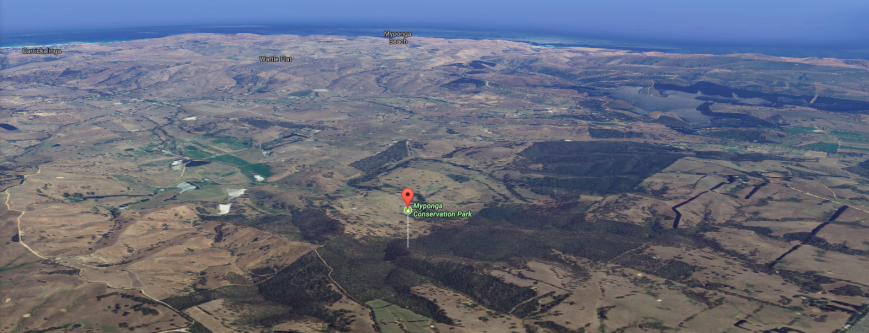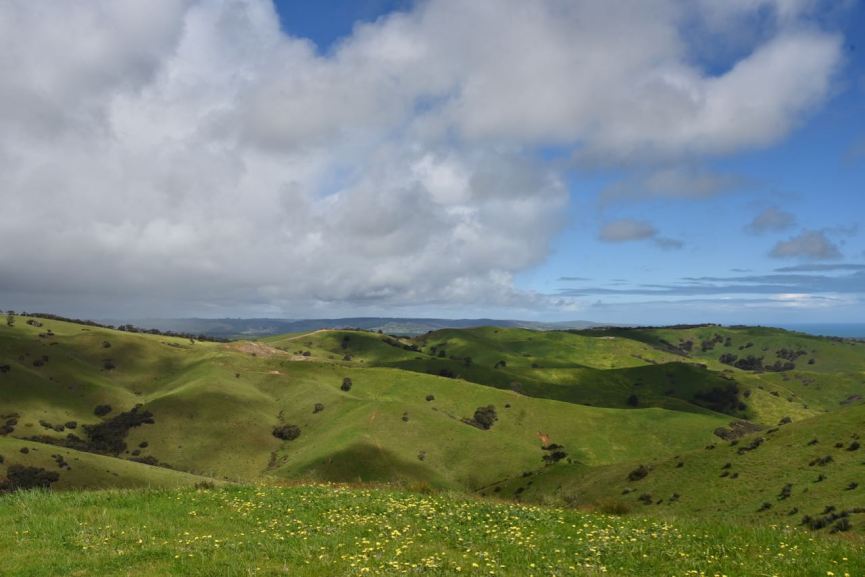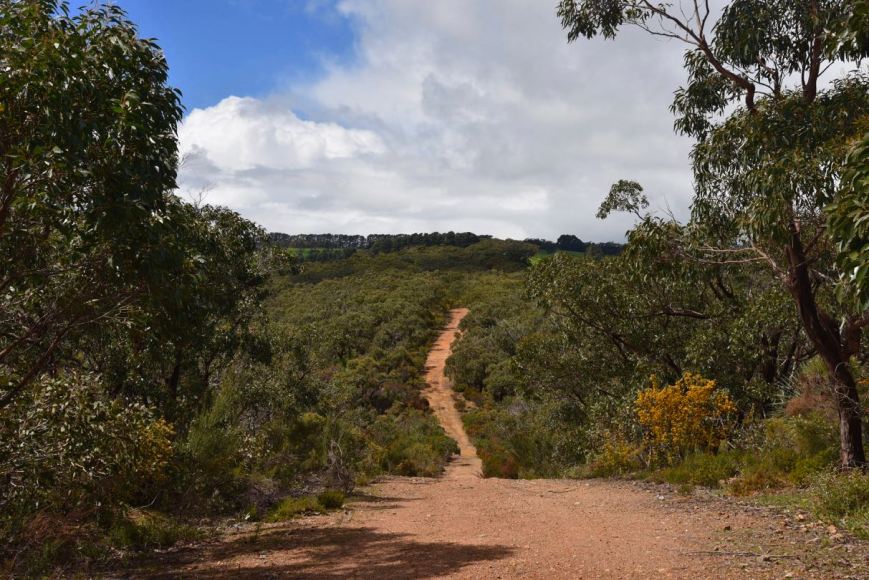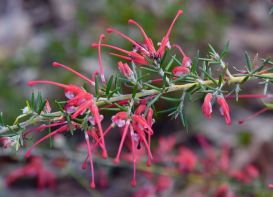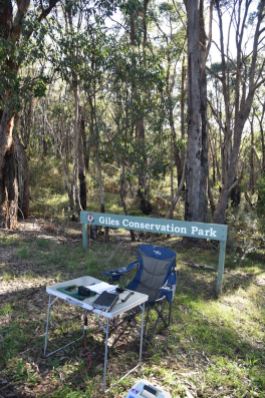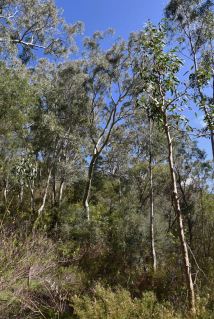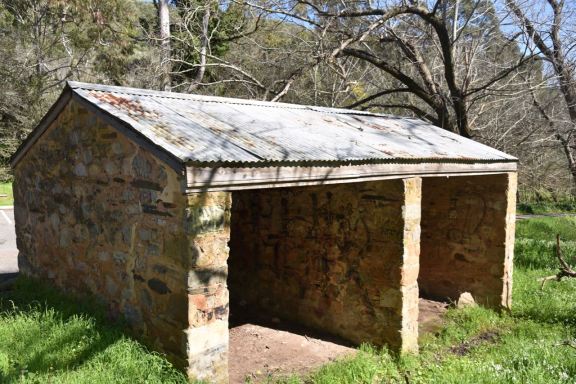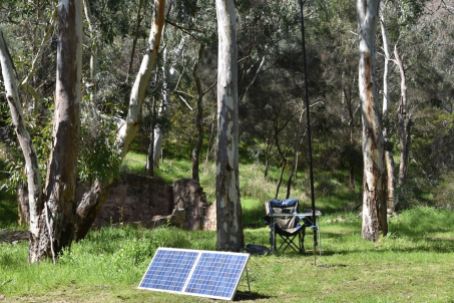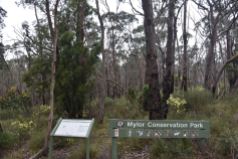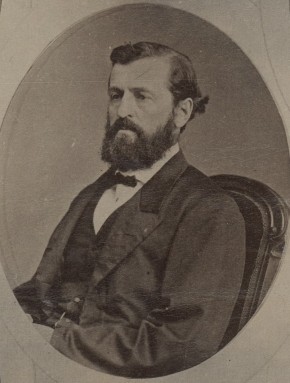This morning (Saturday 30th September 2017) I headed out to activate the Nurragi Conservation Reserve VKFF-2247, which is located about 70 km south east of Adelaide. It was a beautiful Spring day and I had a few hours to spare before the commencement of the AFL Grand Final, in which my team, the Adelaide Crows played. I shouldn’t have rushed home! Sadly they were beaten.

Above:- Map showing the location of the Nurragi Conservation Reserve. Map courtesy of Google maps
The Nurragi Conservation Reserve follows the old branch railway line to Milang and runs a distance of about 12 km, from Sandergrove to Milang. The park is about 65 hectares in size. The Friends of Nurragi was established in 1988 to protect and restore the reserve and in 1991 the Minister of Lands dedicated the area as a Nature Conservation and Plantation Reserve under the Crown Lands Act 1929.
The park commences at the town of Milang, which is located on the banks of Lake Alexandrina. Between 1860 and 1880 Milang was one of South Australia’s busiest ports. It connected Adelaide with the thriving river trade. Wool from the Darling and Upper Murray stations was landed at Milang and then transported by horse and bullock teams to Port Adelaide. Wheat was transported to Milang, processed at its flour mills and then shipped back as flour.

Above:- Aerial shot showing the park, looking north west, with Adelaide in the background. Image courtesy of Google maps
The reserve forms a wildlife corridor linking the eastern Mount Lofty Ranges with Lake Alexandrina and contains extremely important vegetation in a region that has been cleared of over 98% of its original cover. More than 300 native plant species are present, with over 50 of those being of particular conservation significance (eg rare or endangered). It preserves remnant mallee vegetation including square-fruited mallee, narrow-leaved red mallee, peppermint box, and native apricot. Understorey plants include wallowa, needle bush wattle and broombush.
Over 95 species of birds have been recorded in the park including Peaceful Dove, Weebill, Australian Magpie, Little Raven, Grey Shrikethrush, Diamond Firetail, Southern Boobook, Red-capped Robin, Hooded Robin, and Rufous Whistler. Native mammals found in the park include Western Grey kangaroos, Brush-tailed possums and bats. About 11 reptile species have been recorded including the Sand Goanna.
During my visit to the park, Superb Blue Wrens and New Holland Honeyeaters were in abundance.
I have activated the park previously, in August this year, and I headed roughly to the same location as my previous activation, on Nurragi Road. This time I activated from the eastern side of the road.
There were some wooden benches already in place in the park, so the deck chair remained in the back of the Toyota Hi Lux. I ran the Yaesu FT-857d, set at 40 watts output, and the 20/40/80m linked dipole for this activation.

Above:- Aerial shot showing my operating spot in the park. Image courtesy of Google maps
Before calling CQ I had a tune around the band and worked Tony VK3CAB/p in the Pauline Toner Butterfly Nature Conservation Reserve VKFF-2175. I had heard Tony on my way to the park, but he was not quite strong enough from the mobile for me to work. I then found Gerard VK2JNG/p calling CQ from the Rawdon Creek Nature Reserve VKFF-1990. It was a nice way to start the activation, with two Park to Park contacts.
I then headed to 7.149 and called CQ. This was answered by Mike VK3KMH, followed by Geoff VK3SQ and then Keith VK2PKT. A little pile up soon ensued, with callers from VK2, VK3, VK4, VK5 and VK7. Band conditions were okay, but there was a little fading (QSB) noted on some signals. Close in propagation on 40m was not brilliant again, with just Marija VK5FMAZ and Greg VK5GJ logged. Both were within 40 km from the park. Greg was running QRP, just 4 watts and Marija was using her allocated 10 watts PEP.
A number of stations calling me were struggling with noise. Fortunately from the park I had zero man made noise. I would encourage anyone who has never undertaken a park or a SOTA activation to give it a try. There is generally no noise, and you can literally hear a pin drop.
I logged a total of 36 stations on 7.149 before callers slowed down. I took the opportunity of having a look around the 40m band and found Chris VK5FR/p on 7.100 operating portable from the Black Hill Conservation Park VKFF-0766. Chris was quite low down, as I was to him, but due to the low noise floor we were able to comfortably work each other. I was really pleased to get Chris in the log. Chris commenced his 900km bike riding journey of the Mawson Trail this morning, with a number of park activations along the way. You can follow the journey of Chris at…….
https://share.findmespot.com/shared/faces/viewspots.jsp?glId=1Rep6cPUFdfzsmXl0By86ZQZzWXrEA0PQ
(Password is vk5fr).

Above:- The Mawson Trail, c/o Trails SA
I then headed to 3.610 on the 80m band, where first in the log was my lovely wife Marija VK5FMAZ, followed by Greg VK5GJ and then Hans VK5YX. Despite the band being wide open to South Australia (VK5), I only worked a further 2 stations….Adrian VK5FANA and John VK5BJE.
I then headed to 14.310 on the 20m band where I logged a total of 5 stations from Queensland (VK4) and Western Australia (VK6).
To complete the activation I moved back to 40m. I had seen a spot on parksnpeaks for Neil VK4HNS/p, so I headed to 7.160 where I logged Neil who was activating the Bendidee National Park VKFF-0030. I then worked Joe VK3YSP/7, Julie VK3FOWL/7 and Anthony VK3YSA/7, all of whom were in the Narawntapu National Park VKFF-0005 in Tasmania. I then called CQ on 7.150 and this was answered by Les VK5KLV, followed by Bruce VK3PNG/p.
It was about this time that I had some bushwalkers come by. They stopped and sat on the bench alongside of me to enjoy their lunch and have a listen to what I was up to. I logged a further 9 stations from VK2 and VK3, before I had to go QRT for the day and head home to watch the footy.
It was a great morning out in the park, with a total of 65 contacts in the log, including 7 Park to Park QSOs. Shame about the footy. But I am still proud of the Crows for making the Grand Final. There is always next year and the world still turns.
I worked the following stations on 40m SSB:-
- VK3CAB/p (Pauline Toner Butterfly Nature Conservation Reserve VKFF-2175)
- VK2JNG/p (Rawdon Creek Nature Reserve VKFF-1990)
- VK3KMH
- VK3SQ/p
- VK2PKT
- VK3SFG
- VK3ARH
- VK3ANP
- VK2HHA
- VK3ZLD
- VK3ZIP
- VK2XXM
- VK3FSPG
- VK3MPR
- VK3MRH
- VK3WAC/m
- VK5FMAZ
- VK3DAC
- VK3GMC
- VK5WAT/3
- VK5GJ
- VK3FQ
- VK3UH
- VK3PF
- VK3FONZ/m
- VK3UCD
- VK2KYO
- VK2NP
- VK2MTC
- VK3ZE
- VK3FCMC
- VK3MSQ
- VK2VRC
- VK7PRN
- VK3MKM
- VK7JN
- VK2SVN
- VK3VGB
- VK5FR/p (Black Hill Conservation Park VKFF-0766)
- VK4HNS/p (Bendidee National Park VKFF-0030)
- VK3YSP/7 (Narawntapu National Park VKFF-0005)
- VK3FOWL/7 (Narawntapu National Park VKFF-0005)
- VK3YSA/7 (Narawntapu National Park VKFF-0005)
- VK5KLV
- VK3PNG/p
- VK3FAHS/p
- VK2IO
- VK3GGG
- VK3PMG
- VK3ANL
- VK3PAT
- VK3JP
- VK2GSP
- VK3MB
- VK2VW
I worked the following stations on 80m SSB:-
- VK5FMAZ
- VK5GJ
- VK5YX
- VK5FANA
- VK5BJE
I worked the following stations on 20m SSB:-
- VK4AAC
- VK6NI
- VK4RF
- VK4HA
- VK6MMB
References.
Birds SA, 2017, <http://www.birdssa.asn.au/location/nurragi-conservation-reserve/>, viewed 11th August 2017
National Trust, 2017, <https://www.nationaltrust.org.au/places/nurragi-conservation-reserve/>, viewed 11th August 2017
Walking SA, 2017, <https://www.walkingsa.org.au/walk/find-a-place-to-walk/nurragi-conservation-reserve-walking-trail/>, viewed 11th August 2017
















